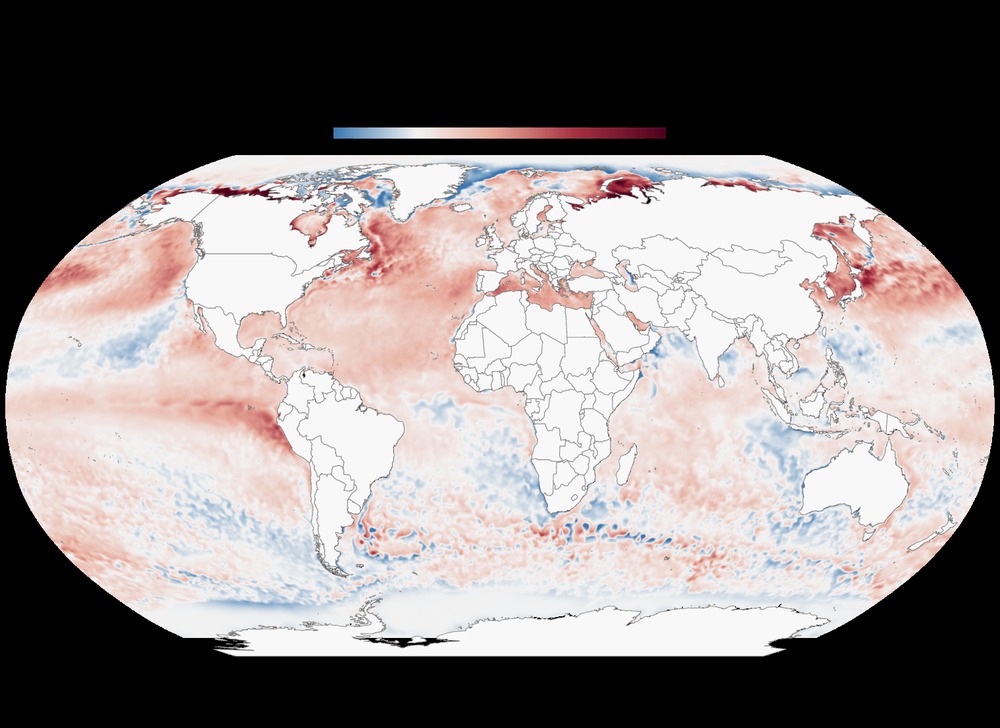Spiny Norman said:
Pretty much on topic, sea temperature increases.
_______________________________________
The ocean plays an integral role in shaping our climate and weather patterns.
The warmer the ocean temperatures, the more power they give to weather systems — fuelling heavy rainfall and extreme bouts of heat by increasing evaporation and rearranging weather patterns.
CSIRO honorary fellow Dr Wenju Cai, who specialises in global climate variability and change, says it is only a matter of time before humans feel that power.
“I think we are definitely going to see a lot of extremes in the upcoming years simply because the system is more powerful,” he said.
“There is a great deal of energy in that ocean warming, and it could power so much more extreme events.”
Many climate scientists believe it already has.
https://www.abc.net.au/news/2023-08-21/ocean-tempertature-records-2023/102701172
Global sea surface temperature anomaly
July 31, 2023

A look at daily sea surface temperature anomalies from around the world shows most of the northern hemisphere and much of the southern hemisphere is currently flashing red.
Georgia Institute of Technology climate scientist Annalisa Bracco said what made this year’s ocean temperatures especially “peculiar” were how widespread the heat was.
“It’s been nearly everywhere,” she said.
During July, sea surface temperatures across much of the Mediterranean Sea were as much as 3 degrees Celsius higher than normal, with pockets up to 5.5C above average along the coasts of Italy, Greece and North Africa.
Dr Bracco said it was “very plausible” these warm ocean temperatures aided extreme weather events in 2023, although formal studies would be required to confirm it.
Scientists believe climate change has played a clear role in the ocean temperature spike.
The difference this year, they say, is that it has been superimposed over myriad natural climate drivers that are no longer disguising its full impacts as they have in the past.
Global CO2 emissions from fossil fuels
Highest = 37.1 billion metric tons

For decades, human activity has been emitting increasing levels of greenhouse gasses that have trapped more of the sun’s energy in the Earth’s system, warming the atmosphere, ocean and land.
Of this extra heat energy, about 90 per cent is stored in the oceans, according to the World Meteorological Organization (WMO).
Research has found once carbon dioxide is added to the atmosphere, it hangs about for 300 to 1,000 years.
Data from the National Oceanic and Atmospheric Administration (NOAA) shows a general upward trend of sea surface temperatures since 1901, which have accelerated from the 1970s onwards.
Annual sea surface temperature

But Dr Cai said the true “pain” of this energy imbalance had been masked through many individual years by a countering cooling influence from various natural climate drivers, something that was missing this year.
“It’s like an anaesthetic to the pain caused by global warming,” he said.
“That anaesthetic is wearing out and we are now feeling it.”
Dr Cai said the most significant of these so-called anaesthetics was the La Niña climate pattern, the “cool” phase of the El Niño Southern Oscillation (ENSO), which occurred for three years in a row from 2020-2022.
The major climate driver features cooler-than-normal sea surface temperatures in the central and eastern equatorial Pacific, and warmer waters on the western side of the Pacific, in turn affecting rainfall and temperatures across the world.
The event has been linked to a significant reduction in average global surface temperatures, with the surface primarily made up of oceans.
The extra heat fostered by greenhouse gasses does not suddenly go missing during a La Niña climate pattern, it is just hidden below the sea’s surface.
With the triple-dip La Niña event now finished, Dr Cai said it was no longer there to act as a buffer.
“There is no break on global warming anymore, and so global warming will power up,” he said.
Instead, the world is staring down the barrel of El Niño — its opposite phase — which is known to raise global surface temperatures.
The last El Niño event was in 2015 to 2016, which also happened to be the warmest year on record for global average surface temperatures on land and sea.
But Dr Cai said the Earth this year was “eight years of background warming” worse off than in 2016.
Another part of the overall story is the melting of ice, Dr Cai says.

This year has already produced record high global ocean temperatures and low Antarctic sea ice. Supplied: Australian Antarctic Division
The bright, smooth surface of the ice reflects a lot of sunlight back into space, meaning its heat is not absorbed into the ocean.
The more it melts, the hotter the oceans get, and vice versa.
For this reason, Dr Cai said ice was the “most powerful atmospheric positive feedback in our Earth’s system”.
Antarctic sea ice extent this year has fallen to record lows and is struggling to recover substantially during the winter months like normal.
Antarctic sea ice anomaly
Daily sea ice extent compared to the 1980-2011 longterm average

Data shows sea ice deficit for July was 2.1 million square kilometres below average — an area bigger than the size of Queensland.
Arctic sea ice, and Greenland and Antarctic ice sheets, are also in decline and have been for decades.
These are just some of the factors lining up this year, with many more likely to be contributing.
Dr Collins said the exact anatomy of what had caused this year to see such extremes was a “puzzle that was going to occupy scientists for a few years”.
But the broader message from climate scientists is that, even though the background warming has this year been emphasised by natural drivers, it would not be the last year like it.
“There will be other years in the future where this happens, because there will be other years where the natural variability tips us into a warm year and that will be on top of an even warmer background trend ,” Dr Collins said.
Dr Bracco said this year’s record was indicative of a level of background global warming that could not be undone for hundreds of years, and urgent action was needed to stop it getting worse.
“It’s getting worrisome,” she said.
“I hope this is a situation that gets people, politicians and administrators together to act on it.”
As for this year, Dr Cai said with El Niño in its infancy, there was likely more heat to come and it would be harshest for those countries entering summer, including Australia.
El Niño had also been linked to increased global mean temperatures in the following year, according to the WMO.
But climate scientists have previously said Australia will not see a mirror of what was experienced in the northern hemisphere because of the local weather systems at play.
More detail.
https://www.abc.net.au/news/2023-08-21/ocean-tempertature-records-2023/102701172









